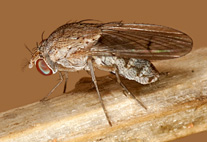Abstract
A first comprehensive phylogeny of the entire family Curtonotidae is generated from molecular markers and morphology. The molecular data set comprises 33 taxa (30 in-group Curtonotidae; three out-groups: Camilla, Diastata, Drosophila) and 4 gene regions from 3 genes: 2 non-contiguous fragments from the CPSase (carbamoylphosphate synthetase) domain of the nuclear protein coding gene CAD (= CAD1 and CAD3); a fragment from the coding region of TPI (triosephos-ophate isomerase); and a fragment of the mitochondrial gene CO1 (cytochrome oxidase 1). We performed Bayesian like-lihood analyses in the program MrBayes 3.2; maximum likelihood analyses in the program Garli 2.0; and parsimony analysis in TNT on the concatenated genetic dataset. A data matrix of 62 discrete, morphological features of imagines was compiled from 75 taxa (70 in-group Curtonotidae taxa and five out-group exemplars: Amiota, Camilla, Diastata, Droso-phila, Stegana), and these data are presented as Appendix II. For the combined morphological and molecular data a Bayes-ian likelihood analysis in the program MrBayes 3.2 and a parsimony analysis in TNT were performed, and for the morphological dataset a parsimony analysis was carried out in TNT. Results of the molecular and morphological analyses attest to the monophyly of the Curtonotidae and clearly indicate two primary clades, with Axinota + Curtonotum being sister to the remainder of the Curtonotidae. Curtonotum sensu stricto (sensu Klymko and Marshall 2011) is here adopted and ten newly-defined species-groups of the genus Curtonotum are recognised the: anus; boeny; campsiphallum; gonzo; platyphallum; rinhatinana; saheliense; striatifrons; stuckenbergi; and uncinatum species-groups. The following nomen-clatorial changes are proposed: Cyrtona appendiculata Séguy, 1938 is formally re-instated as a valid species and is re-moved as a junior synonym of Cyrtona pictipennis (Thomson, 1869). The former variety name sublineata (Duda, 1939) is upgraded to a specific name, as Parapsinota sublineata (Duda, 1939). The continental Afrotropical fauna of the genus Curtonotum Macquart, 1844 is revised and a diagnosis of the genus is provided. Known biology, behaviour and published information on immature stages of the genus are briefly reviewed. Type material of 12 of the 13 named species (C. ango-lense Tsacas, C. campsiphallum Tsacas, C. cuthbertsoni Duda, C. herrero Tsacas, C. pauliani Tsacas, C. platyphallum Tsa-cas, C. quinquevittatum Curran, C. saheliense Tsacas, C. sao Tsacas, C. simile Tsacas, C. striatifrons Malloch and C. tigrinum Séguy), was studied and errors in previous interpretations and designation of type specimens are resolved. Cur-tonotum pauliani is the only species occurring on both the continental African mainland and Madagascar. The type spec-imen of C. maculiventris (Enderlein) is lost and a neotype is here designated. One species synonymy is proposed: C. tigrinum Séguy, 1933 = C. maculiventris (Enderlein, 1917), syn. n. Additional material of the aforementioned species is noted, substantially increasing their known distributions. Thirteen species are described as new, namely: C. bicuspis Kirk- Spriggs, sp. n., C. cimbebas Kirk-Spriggs, sp. n., C. constance Kirk-Spriggs, sp. n., C. freidberg Kirk-Spriggs, sp. n., C. gonzo Kirk-Spriggs, sp. n., C. hay Kirk-Spriggs, sp. n., C. litoralis Kirk-Spriggs, sp. n., C. marriott Kirk-Spriggs, sp. n., C. mcgregor Kirk-Spriggs, sp. n., C. moffatt Kirk-Spriggs, sp. n., C. tsacas Kirk-Spriggs, sp. n., C. uncinatum Kirk- Spriggs, sp. n. and C. unicuspis Kirk-Spriggs, sp. n. The head and thorax, frons, wing, fifth sternite and hypandrium of the male of the 25 named species are illustrated for the first time, as well as the highly diagnostic male phallus, from both the right and left sides laterally. A key to species based on male characters is provided, and species distributions are mapped and interpreted according to major vegetation types, topography and humidity zones. The biogeographical signif-icance of the continental Afrotropical species is discussed. Co-ordinates used to plot maps and a list of Major Habitat Types and Vegetation Types in which species occur are provided as Appendix III.

